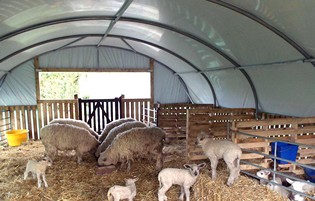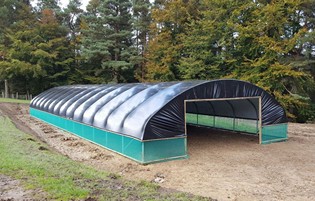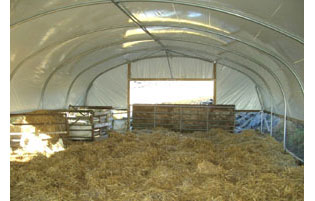 The unpredictable UK weather can prove problematic for farmers, so it’s important to plan for all eventualities and ensure your livestock remain adequately protected.
The unpredictable UK weather can prove problematic for farmers, so it’s important to plan for all eventualities and ensure your livestock remain adequately protected.
Lambing season, for example, is a crucial time for the agricultural industry so it is imperative your sheep are well taken care of in the form of efficient sheep housing.
Sheep polytunnels are the best way to reduce lambing losses by shielding your flock from harsh weather conditions or predators, as well as offering additional feeding help.
We’ve put together this handy guide to help take you through the best practices when it comes to meeting your sheep housing requirements.
Plan carefully
Before you start constructing your sheep house, you need to think clearly about its layout and how it will best serve you. A well-designed sheep polytunnel should make feeding as labour efficient as possible, while you should also consider all the other tasks you may need to carry out and whether your setup will help or hinder those.
For example, it’s worth taking into account the layout of the pens, where to put the passageways and the gates which, when open, can also be used to block off the walkways.
Make space
 When seeking guidance on your sheep housing requirements, The Department for Environment, Food and Rural Affairs (DEFRA) has regulations in place when it comes to space allowances, feeding and wellbeing, among other factors. It is suggested that you should be able to feed every 100 ewes in around 15 minutes, and careful placement of troughs mean you should be able to do so without entering the pens.
When seeking guidance on your sheep housing requirements, The Department for Environment, Food and Rural Affairs (DEFRA) has regulations in place when it comes to space allowances, feeding and wellbeing, among other factors. It is suggested that you should be able to feed every 100 ewes in around 15 minutes, and careful placement of troughs mean you should be able to do so without entering the pens.
Not everyone has the same area within which to work, of course, but thankfully Premier Polytunnels offer a range of sizes in sheep housing, from 16 feet wide to 30 feet.
Bed with clean, dry straw
 The floor of your sheep polytunnel is critical, as poor-quality straw can lead to lameness or other infections which, within the contained environment of a sheep house, could spread quickly and badly affect your flock and therefore profitability.
The floor of your sheep polytunnel is critical, as poor-quality straw can lead to lameness or other infections which, within the contained environment of a sheep house, could spread quickly and badly affect your flock and therefore profitability.
Maintaining a policy of using clean, dry straw will help to guard against these dangers and adequate drainage will ensure your sheep house remains a pleasant place to be – both for you and the sheep!
Ventilation is key
The sides of your sheep polytunnel need to include properly designed ventilation, as sheep are “particularly susceptible to respiratory diseases”, according to DEFRA.
Sheep prefer naturally ventilated cold housing, therefore installing ventilation that runs the full length of your sheep house will maximise air flow and help to avoid respiratory problems, such as pneumonia and bronchitis, in the flock.
Choose your materials wisely
It’s important to disinfect the surfaces inside your sheep polytunnel regularly and thoroughly to avoid the risk of infection. It’s also worth considering materials that are easy to clean or, if required, straightforward to replace. When treating any indoor surfaces with preservatives, be careful to select those that will not harm the health of your sheep.
Make access easy
While your flock should always be provided with enough opportunity to earn a rest from artificial lighting, your lights should be set up to ensure that you can see all sheep and that they can be inspected at any time.
When it comes to cleaning out, being able to drive straight in at either end of your sheep house with a quad bike or compact tractor could your life easier. Fewer pens – and therefore fewer divides between pens – may also prove more time efficient and leave you able to focus more clearly on the likes of feeding and lambing.
Once you’ve considered all these factors, you will be able to provide your sheep with the perfect housing to keep them safe and comfortable.